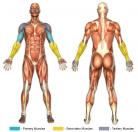Curls (Dumbbell)
- Stand or sit (on a bench) with your arms at your sides.
- Grasp the weight in the desired fashion (usually with the palm facing inward - see below for clarification). Note: The curling motion can be performed three ways: alternating arms, both arms at the same time, or one arm at a time.
- Curl the weight upward (usually rotating the forearm so that the palm is facing outward before the forearm is horizontal), while exhaling throughout the movement.
- Lower the weight slowly, inhaling throughout the movement.
- Repeat steps 3-4 for as many sets as are desired. (Sets should generally fall between 3 to 6 with 6-12 repetitions).
For a more intense exercise, try Concentration Curls
The curling motion can be performed three ways: alternating arms, both arms at the same time, or one arm at a time.
Dumbbell biceps curls allow for self-spotting, if one arm is exercised at a time. This is an additional property of this exercise that adds to its appeal. To self-spot on curls, simply use your free hand to gently help (via touch spot) the working arm to raise the weight when it becomes too difficult to lift unassisted.
By merely changing the way your forearm (and consequently, hand) is positioned you can adjust which/(how the) muscles will be targeted, to at least some degree; this is done through pronation and supination of the forearm. Supination is the position of your forearm when your palm is facing outward/upward, and, conversely, pronation is when your palm is facing inward. Note that for most people anatomy will inhibit the forearm from pronating as far inward as it will allow the forearm to supinate outward.
So, to emphasize the biceps brachii, keep your forearm supinated (so that your thumb is pointed outward, i.e. your palm is facing outward/forward in respect to your body); to incorporate more brachioradialis, pronate your forearm (so that your thumb is pointed up, i.e. your palm is facing inward in respect to your body). In the case of curls, keeping the hand position neutral is the "hammer curl" variety of curls.
Some people may develop elbow (tendon) pain if they do curls incorrectly. Three things to remember to greatly reduce the chance of elbow injury are:
- Always control the weight, especially during the down movement. Letting the weight drop as the elbow reaches the bottom "locked" position causes tremendous stress on it that will likely result in injury.
- Keep your wrists straight (neutral). It is in this manner that maximum biceps stress will be achieved. Bending your wrist in either direction (upward or downward) removes focus from the intended muscle, the biceps, and creates vulnerability to injury (elbow or wrist).
- Keep your elbows at your side throughout the movement, especially if you are a novice. Many people can raise their elbows (forward) at the top of the curl movement without becoming injured, though by raising the elbows the anterior deltoids become far more involved. If you are looking for a shoulder workout, then shoulder exercises better serve this purpose. However, there are experts who claim that raising the elbow(s) forward allows for a fuller contraction of the biceps. Use good judgment when determining whether or not to perform curls this way.





